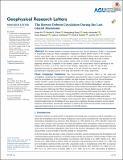| dc.contributor.author | Fu, Qiang | |
| dc.contributor.author | White, Rachel H. | |
| dc.contributor.author | Wang, Mingcheng | |
| dc.contributor.author | Alexander, Becky | |
| dc.contributor.author | Solomon, Susan | |
| dc.contributor.author | Gettelman, Andrew | |
| dc.contributor.author | Battisti, David S. | |
| dc.contributor.author | Lin, Pu | |
| dc.date.accessioned | 2020-05-15T14:20:54Z | |
| dc.date.available | 2020-05-15T14:20:54Z | |
| dc.date.issued | 2020-02 | |
| dc.date.submitted | 2020-01 | |
| dc.identifier.issn | 0094-8276 | |
| dc.identifier.issn | 1944-8007 | |
| dc.identifier.uri | https://hdl.handle.net/1721.1/125265 | |
| dc.description.abstract | The Brewer-Dobson circulation during the Last Glacial Maximum (LGM) is investigated in simulations using the Whole Atmosphere Community Climate Model version 6. We examine vertical mass fluxes, age of stratospheric air, and the transformed Eulerian mean stream function and find that the modeled annual-mean Brewer-Dobson circulation during the LGM is almost everywhere slower than that in the modern climate (with or without anthropogenic ozone depleting substances). Compared to the modern climate, the annual-mean tropical upwelling in the LGM is 11.3–16.9%, 11.2–15.8%, and 4.4–10.2% weaker, respectively, at 100, 70, and 30 hPa. Simulated decreases in annual-mean mass fluxes at 70 and 100 hPa are caused by a weaker parameterized orographic gravity wave drag and resolved wave drag, respectively. | en_US |
| dc.description.sponsorship | National Science Foundation (Grant AGS‐1821437) | en_US |
| dc.description.sponsorship | NASA (Grant 80NSSC18K1031) | en_US |
| dc.language.iso | en | |
| dc.publisher | American Geophysical Union (AGU) | en_US |
| dc.relation.isversionof | http://dx.doi.org/10.1029/2019gl086271 | en_US |
| dc.rights | Creative Commons Attribution 4.0 International license | en_US |
| dc.rights.uri | https://creativecommons.org/licenses/by/4.0/ | en_US |
| dc.source | American Geophysical Union (AGU) | en_US |
| dc.title | The Brewer‐Dobson Circulation During the Last Glacial Maximum | en_US |
| dc.type | Article | en_US |
| dc.identifier.citation | Fu, Qiang et al. "The Brewer‐Dobson Circulation During the Last Glacial Maximum." Geophysical Research Letters 47, 5 (February 2020): e2019GL086271 © 2020 The Authors | en_US |
| dc.contributor.department | Massachusetts Institute of Technology. Department of Earth, Atmospheric, and Planetary Sciences | en_US |
| dc.contributor.department | Massachusetts Institute of Technology. Department of Chemistry | en_US |
| dc.relation.journal | Geophysical Research Letters | en_US |
| dc.eprint.version | Final published version | en_US |
| dc.type.uri | http://purl.org/eprint/type/JournalArticle | en_US |
| eprint.status | http://purl.org/eprint/status/PeerReviewed | en_US |
| dc.date.updated | 2020-05-06T18:10:38Z | |
| dspace.date.submission | 2020-05-06T18:10:42Z | |
| mit.journal.volume | 47 | en_US |
| mit.journal.issue | 5 | en_US |
| mit.license | PUBLISHER_CC | |
| mit.metadata.status | Complete | |
